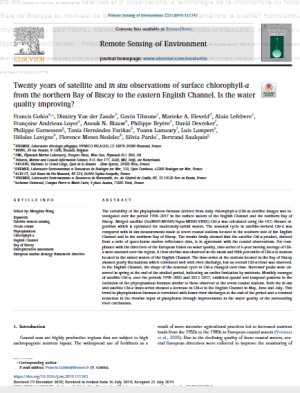
Depuis 20 ans, lIfremer suit par satellite les niveaux de micro-algues, qui constituent le plancton végétal marin. Bilan sur les avantages de cette méthode ainsi que sur les tendances en Manche et dans le nord du golfe de Gascogne. The variability of the phytoplankton biomass derived from daily chlorophyll-a (Chl-a) satellite images was investigated over the period 19982017 in the surface waters of the English Channel and the northern Bay of Biscay. Merged satellite (SeaWiFS-MODIS/Aqua-MERIS-VIIRS) Chl-a was calculated using the OC5 Ifremer algorithm which is optimized for moderately-turbid waters. The seasonal cycle in satellite-derived Chl-a was compared with in situ measurements made at seven coastal stations located in the southern side of the English Channel and in the northern Bay of Biscay. The results firstly showed that the satellite Chl-a product, derived from a suite of space-borne marine reflectance data, is in agreement with the coastal observations. For compliance with the directives of the European Union on water quality, time-series of 6-year moving average of Chl-a were assessed over the region. A clear decline was observed in the mean and 90th percentile of Chl-a at stations located in the mixed waters of the English Channel. The time-series at the stations located in the Bay of Biscay showed yearly fluctuations which correlated well with river discharge, but no overall Chl-a trend was observed. In the English Channel, the shape of the seasonal cycle in Chl-a changed over time. Narrower peaks were observed in spring at the end of the studied period, indicating an earlier limitation by nutrients. Monthly averages of satellite Chl-a, over the periods 19982003 and 20122017, exhibited spatial and temporal patterns in the evolution of the phytoplankton biomass similar to these observed at the seven coastal stations. Both the in situ and satellite Chl-a times-series showed a decrease in Chl-a in the English Channel in May, June and July. This trend in phytoplankton biomass is correlated with lower river discharges at the end of the period and a constant reduction in the riverine input of phosphorus through improvements in the water quality of the surrounding river catchments. [R.A.]

